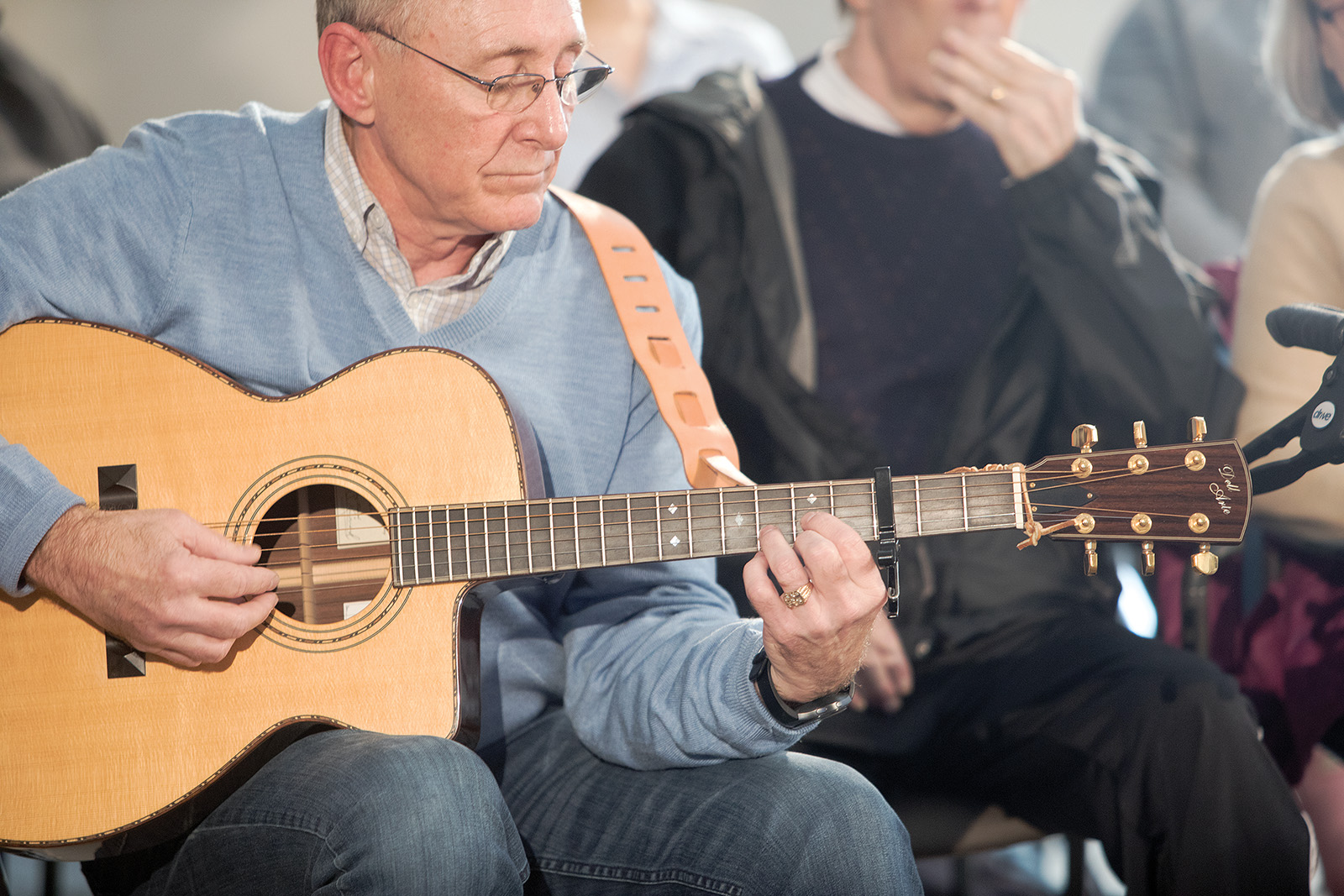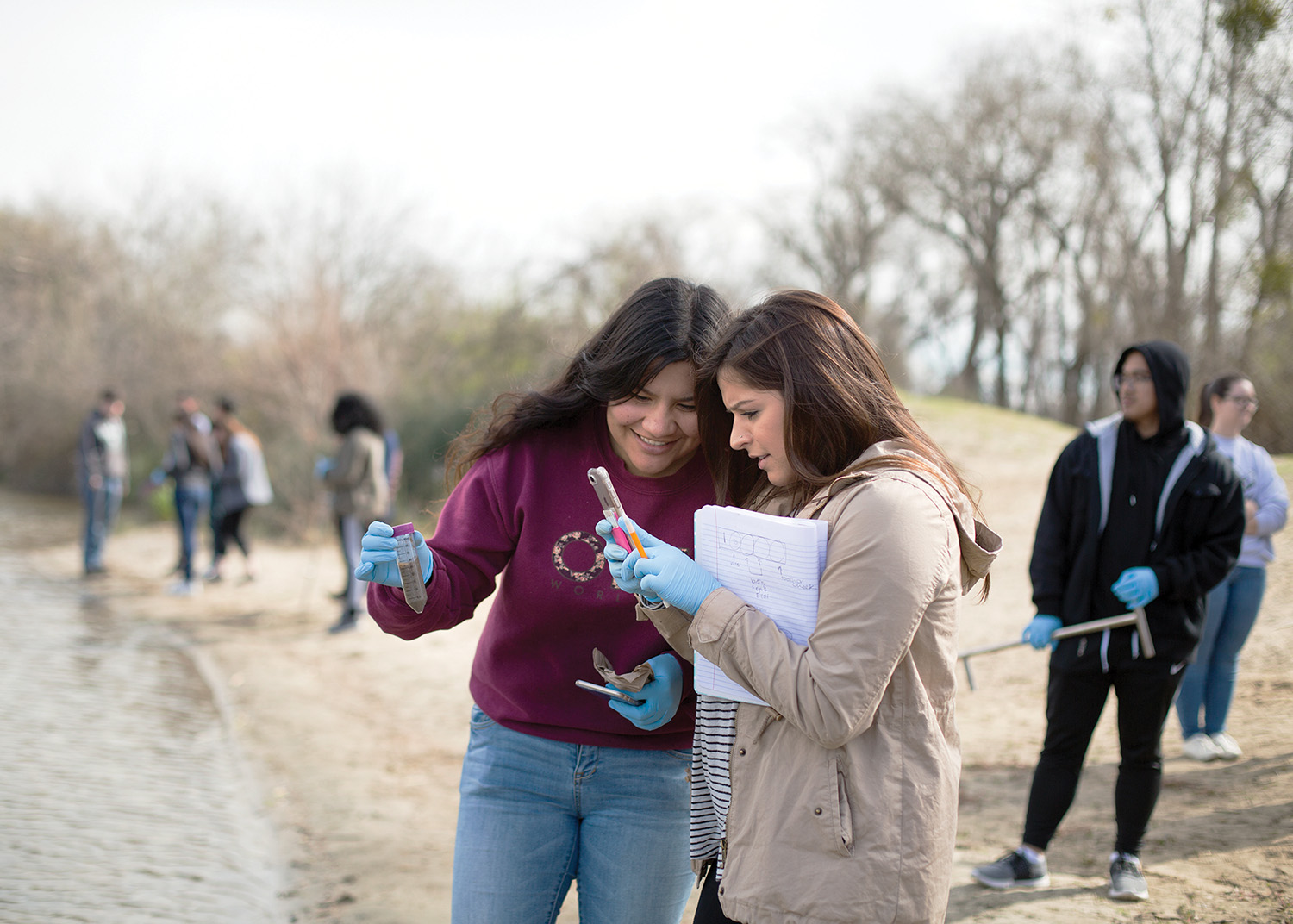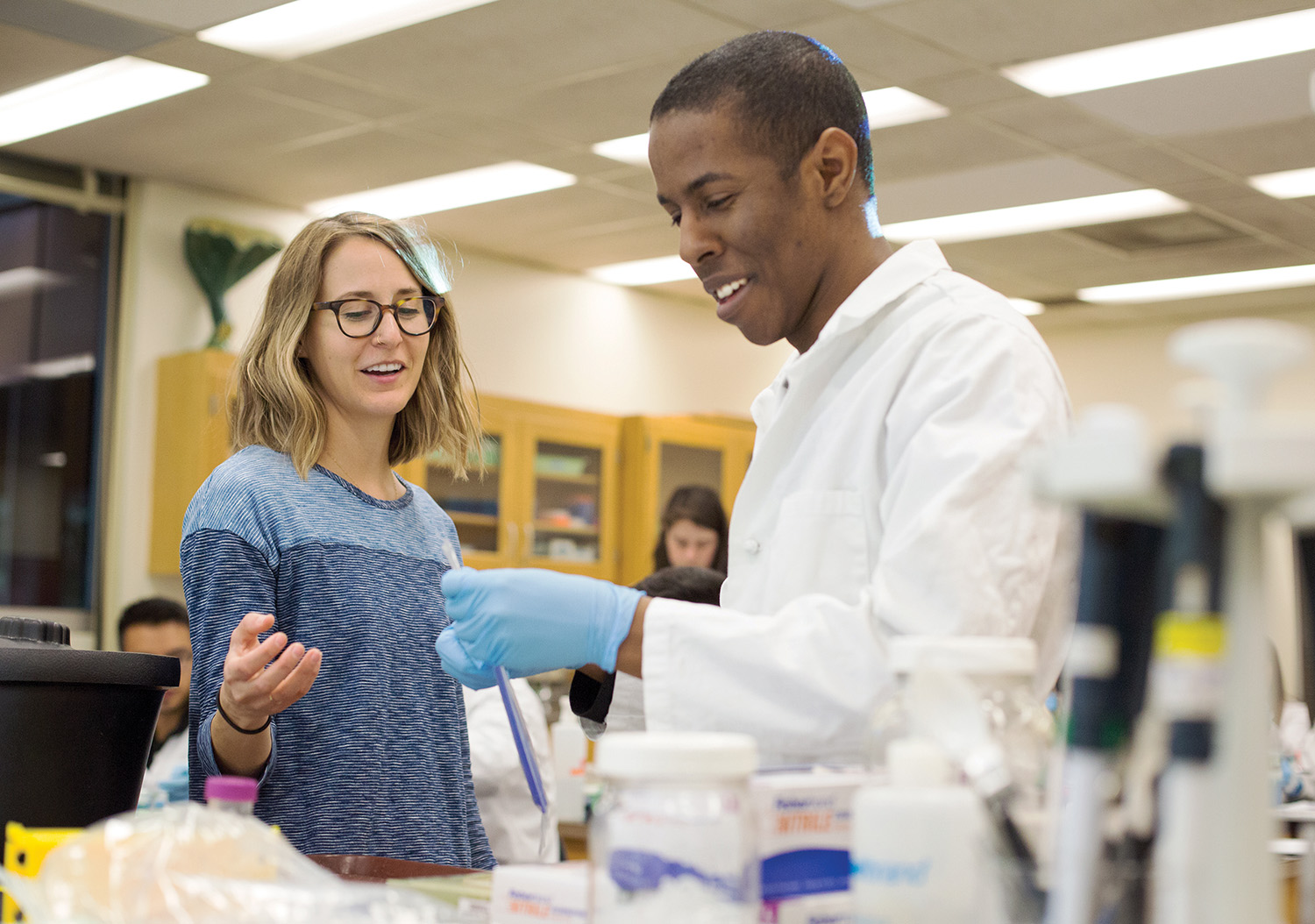

Across the University
Innovation flows like a river, soars like a song
Anita Fitzhugh
The chorus of Neil Diamond’s “Sweet Caroline” echoes throughout a large room in Folsom Hall as singers positioned in a semicircle tap their canes and wheelchairs to the beat of the music.
The Maryjane Rees Language, Speech and Hearing Center at Sacramento State provides services for children and adults with communication disorders. Graduate student clinicians conduct assessments and therapy under the direct supervision of department faculty. These Sac State graduates are highly sought after for employment in public schools, private practices and medical settings.
The participants are mostly stroke survivors who now live with aphasia, or difficulty using language. As part of their therapy, they sing in a choir offered by the Neuro Service Alliance in Sacramento State’s Communication Sciences and Disorders Department.
Word by painstaking word, they follow the lead of two students and an energetic choir director, who are helping them find their voices through lyrics.
That’s one of many scenes at Sac State illustrating academic and programmatic innovation, a colorful, important part of life where intellect, motivation, talent, and passion intersect and thrive.
However they appear, the University’s educational advances are exceptional, and their effects are helping shape students as well as the communities into which those people take their knowledge and skills.
Examples are notable and far from isolated, and they represent just part of the University’s accelerating academic prowess, each as an individual powerhouse and all part of an overarching vision.
“Innovation is at the heart of teaching at Sacramento State,” says President Robert S. Nelsen. “Our faculty immerse our students in hands-on experiences inside and outside the classroom. That’s what makes Sacramento State graduates unique.”
Helping make things clear
On the far southern edge of the campus, where the singing gives aural testament to healing and growth happening there, the Communications Sciences and Disorders Department, through the Maryjane Rees Language, Speech and Hearing Center, provides other educational and clinical opportunities.
It represents a path for graduate student Asmahan Maayeh to turn her passion for language and communications into the master’s degree she seeks in communicative disorders.
Maayeh is among the first in the new and expanded Folsom Hall site where the University works to help people dealing with communication challenges and pursues its mission to educate students in those fields. But she is far from the only person – student or otherwise – to benefit.
“The new clinical space allows us to gain more knowledge and experiences from different types of clients who turn to us for help with a number of speech and sound challenges,” Maayeh says.
The choir is just one example – but a good one.
“Singing is often easier than speaking for individuals with a motor-speech disorder,” says clinic coordinator Jeannette Wilson Reiff. “It is not only therapeutic, but it’s fun, and it also supports individuals’ life participation and social engagement.”
She estimates that each year more than 600 children and adults from around the Sacramento region visit the Maryjane Rees Center, where they receive clinical services for speech and language impairments, language-based reading disorders, stuttering, voice therapy, and neurogenic cognitive-linguistic communication disorders.
John Dutton is one man whose life is being improved by his association with the clinic. Dutton suffered a stroke nearly three years ago, losing abilities that before the stroke had seemed simple.
“When I had my stroke, I was so unprepared for what to do. I could not remember what a computer was called and could not write clearly,” says Dutton, who twice a week visits the clinic, which is supported by donations from clients and community members.
Karla Rojas feels the same. Just one month into her daughter’s speech therapy, Rojas, a mother of two, has noticed a remarkable improvement.
“Her issue is that she wasn’t speaking. Receptively, she understands what you’re saying and will understand commands, but she’s not expressing herself,” Rojas says.
“She would just point and make sounds like ‘eh, eh,’ and so a month in, she’s speaking a lot more. As a parent, you always want the best for your children, and I can’t express how important it has been for our family to do this.”
Wanting – and having the makeup – to help people is why students find the profession attractive, Reiff says.
“When I see progress in clients it’s nothing but heartwarming,” she says. “It’s humbling, it’s a moment in time when you really realize that you’ve touched another person’s life.”
New proposed Sac State degrees include third doctorate
A doctorate is among 12 new academic degrees proposed for Sacramento State, along with a plan to elevate three existing concentrations and add two innovative certificate programs. It's all a part of the University's continuing commitment to be a key contributor to the region’s growing and changing workforce.
The projected doctorate, in audiology, would be the third such professional degree offered by Sac State. Projected to be implemented over the next two years, these are the doctorate and other degree programs:
- Doctorate in audiology
- Master of science in finance
- Master of science in applied behavior analysis
- Master of science in business analytics
- Master of arts in biotechnology
- Master of fine arts in studio art
- Bachelor of fine arts in studio art
- Bachelor of arts in design studies
- Bachelor of fine arts in graphic design
- Bachelor of fine arts in interior architecture
- Bachelor of fine arts in photography
- Bachelor of science in health services
In addition, three concentrations in the Department of Family and Consumer Sciences – fashion merchandising, human development and family studies, and nutrition and food – are eligible to seek elevation to full bachelor of science status.
Finally, the Peace Corps Preparation and Career Pathways in Teacher Preparation certificate programs will be introduced for the Fall 2018 semester.
– Dixie Reid

Ana Laura Cabrera (left) and Natalee DeBortoli, both undergraduates majoring in biology and biochemistry, have gained real-world research experience by joining others in using the American River as a living lab.
Education rolling on the river
Up and over the levee, on a warm February day, a couple dozen undergrads majoring in biology and biochemistry dip their instruments into the American River, using the iconic waterway as a living lab for research. The work being done is a key part of the University’s commitment to education in science, technology, engineering, and mathematics (STEM) fields.
From water at the edge of California’s formative stream, the students, led by biology Professor Kristen Ahrens, pull what could someday be a scientific breakthrough.
That investigation of bacterial abundance and diversity is part of the signature SIRIUS – Sustainable Interdisciplinary Research to Inspire Undergraduate Success – program, which has been supported by more than $1 million in grant funding from the W.M. Keck Foundation, the National Science Foundation and internal and CSU-wide programs.
It’s the sort of undertaking that catches attention.
“The SIRIUS project is novel in both scope and scale,” says biology Professor Thomas Landerholm, co-director of SIRIUS. “It is designed to prepare a highly skilled, diverse workforce by providing an environment for 100 percent of students to engage in research as undergraduates.”
These immersive learning experiences have an impact on students such as Sami Seim, a third-year recreation, parks and tourism administration major minoring in biology.
“I feel like this biology class can help me understand the world around me on a deeper level not just spiritual, but more of the logical intake of how things are and what they are to become,” Seim says.
The hands-on nature of the research program is a fresh alternative to “just sitting there and being drilled with information,” Seim says. “It motivates us to learn so that we are able to complete the tasks that are needed to not only take the class, but to complete it.”
Kelly McDonald, SIRIUS co-director and biology assistant chair, says the Department of Biology adopted this type of research in 12 of its existing laboratory courses.
“After three years of funding, more than 3,800 undergraduate biology students have completed at least one SIRIUS course, and once all courses are fully implemented, more than 3,200 students will complete at least one SIRIUS laboratory annually,” McDonald says.
The attractiveness of the program and its approach could help “increase the participation of underrepresented minority, women, and transfer students in these high-impact learning activities.”

Kristen Ahrens, a Biological Sciences lecturer, speaks with student Jordan Brown during a lab session focusing on the study of cells, molecules, and genes. The American River has become an important teaching tool at the University.
When teachers look like their students
Elsewhere, efforts to educate a more diverse workforce can be seen in the College of Education, where Sacramento State plays a major role in addressing the statewide teacher shortage. A nearly $3 million grant from the U.S. Department of Education is helping.
That money is part of a push to help students graduate with a teaching credential in just four years and in doing so meet a growing demand for underrepresented, bilingual, and special-education teachers.
Alejandro Avalos, a bilingual multiple-subject credential candidate, knows firsthand the importance of having teachers reflect the diversity of students in their classrooms.
“My personal story of growing up in South Sacramento and being involved in gangs is what creates the drive I have to help youth find themselves and not fall victim to the streets,” Avalos says.
Early on, Avalos struggled in school and hung out with the wrong crowd. By middle school, he faced regular suspensions and his name was included on a gang-affiliation list.
But something eventually clicked, and Avalos decided to be a positive influence in his community rather than a drag on it.
The Sac State teaching program is making education an opportunity, not only for him, but for others he hopes to help. Avalos says he plans to return to his old neighborhood and reach back to his childhood experiences to relate to and guide students.
His original plan to be a juvenile gang guidance counselor gave way to a realization that teaching will allow him to “be proactive and help the youth before they hit this stage in their lives.”
Pia Wong, associate dean for Research and Engagement, says Avalos already is making his mark on the future of education as the student representative on Sacramento State’s new Teacher Preparation Task Force, which Wong co-chairs.
The task force works to develop a campus-wide community of teacher-educators across six colleges—Arts and Letters, Natural Sciences and Mathematics, Social Sciences and Interdisciplinary Studies, Health and Human Services, Education, and Engineering and Computer Science—with a common vision of quality teacher preparation for Sac State students.
“There is no more important cause in our region than to prepare a professional corps of culturally, racially, and linguistically diverse educators for the communities of Sacramento and beyond,” Wong says.
Avalos says he is leaning toward teaching social studies at the middle school level, where he hopes his students will find passion and purpose.
“Identifying your weaknesses and your flaws and then working on them is something I want to instill in my students, because we are not perfect and we all make mistakes,” he says.
“My personal story is a testament to that. I was able to learn from my mistakes and failures to get where I am today.”
And the outcome?
“Our goal,” Avalos says, “is to create a program that is diverse and focused on equity and equality that will help teachers with the fundamentals to be great teachers in diverse and culturally rich environments.”
05/04/18